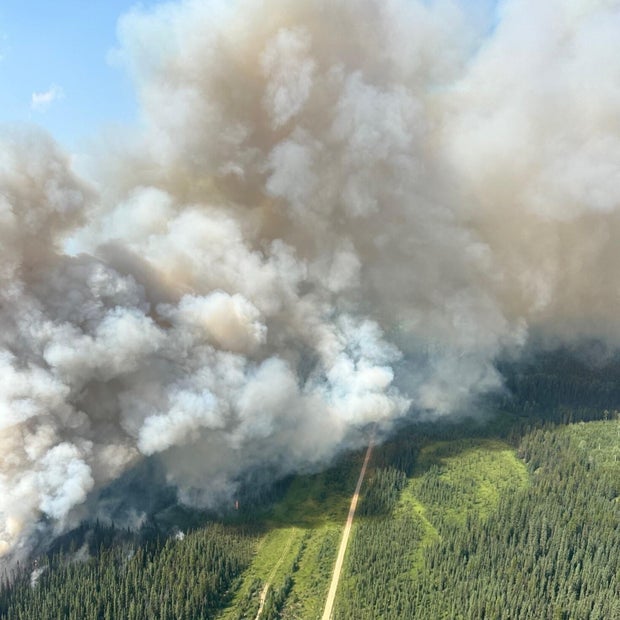CBS News
Canadian wildfire with tropical storm force winds may have destroyed half of a popular town: “Burned to the ground”

Parts of a popular tourist destination in the Canadian Rockies have been “burned to the ground” after a wildfire with tropical storm force winds merged with another fire to burn 89,000 acres, officials said, adding that as much as half of the town may have been severely damaged.
The fires broke out in Alberta, Canada, where they overtook the municipality of Jasper, home to Jasper National Park, the largest national park in the Canadian Rockies and the second-largest dark sky preserve in the world. It started on Monday, when Parks Canada said it was responding to multiple fires. By the next day, Jasper and Jasper National Park had been evacuated, with officials focusing on two blazes – the North Wildfire and the South Wildfire.
“The storm was ferocious – the skies went dark and there were whipping winds, fierce rain and lightning,” BBC journalist Wendy Hurrell, who had been in the national park when the fires began, said. “…It will be a very long time before [Jasper] will recover. It’s utterly devastating for them all and my heart is breaking.”
ALBERTA WILDFIRE/HANDOUT/Anadolu via Getty Images
“Consistently high and gusty” winds caused the fires to spread and grow from the confines of the park to the town itself. On Wednesday night, air quality “deteriorated to the point that wildland firefighters and others without self contained breathing apparatuses needed to evacuate” and the fires had merged, officials said.
“It [was] just a monster at that point,” Pierre Martel, director for Parks Canada’s national fire management program, told the BBC. “There are no tools we have in our tool box to deal with it.”
Thursday saw wind gusts as high as 62 miles per hour – strong enough to be considered a tropical storm had it been a cyclone – and the North and South fires had combined with the nearby Utopia Wildfire, which had almost been contained before the merge. At one point, flames were as high as 328 feet, an official said, according to BBC.
In its latest update, town officials wrote on Facebook that the Jasper Wildfire Complex has burned an estimated 89,000 acres of land, although accurate mapping “has been challenging” due to strong winds, extreme fire behavior, smoke and an inability for aircraft to fly safely.
Thick cloud cover also made satellite imaging difficult on Thursday. Both the town and the national park are under evacuation orders.
“This is the worst nightmare for any community,” Alberta Premier Danielle Smith said during a news conference on Thursday, adding that “potentially 30 to 50%” of buildings had been destroyed.
Canadian talk show host Ryan Jespersen said “there are no words” to describe the damage in Jasper. He posted a video of the damage, showing ashen skies and ground with dead trees and the charred remains of homes and cars. Many buildings in the video are shown to be almost completely gone, with nothing but a few steps remaining in front of nothing but air.
“Jasper is burned to the ground,” he said on social media.
The area saw some relief on Thursday night when temperatures cooled and it started to rain, which the government says will reduce fire behavior for 72 hours. During that time, crews will work to “make as much progress as possible to suppress the wildfire and reduce further spread.” However, officials said that warm weather is expected to resume, increasing the fire’s activity once again.
JASPER NATIONAL PARK /HANDOUT/Anadolu via Getty Images
The same day the fires broke out in Alberta on Monday, Earth had its hottest day ever measured – breaking a record set just hours before. The hotter the planet gets, partially driven by the use of fossil fuels, the more likely areas are to experience the conditions that fuel fires and cause them to rapidly spread – high heat, low humidity, strong winds and dry vegetation.
During Thursday’s press conference, Premier Smith fought back tears and struggled to speak, emotional over the “wall of flames” that had overtaken the town and park that are “a source of pride” for the province, “with some of the most beautiful scenery in the world.”
“Our grandparents visited to experience the majesty of this place, with its mountains and lakes and meadows. They took our parents, who then took us to this special spot that they’d spent time in as children,” she said. “And now we take our own kids and our own loved ones and visitors from around the world to feel that same feeling that you get with your first glimpse of the mountains on the horizon – a feeling that even though you’ve just left home, you’re coming home.”
On its website, Tourism Jasper asked for “patience and grace as many of our residents and businesses navigated this loss and turn to the future rebuilding of our community.”
“Maybe the right words will come eventually. Maybe once the dust settles, and the rain falls, and we have an accurate assessment of the damage, maybe then we’ll be able to fully express our sadness about Jasper’s recent tragedy,” the department said in an emotional note on its website. “…Our mountains have stood tall for millions of years, and Jasper will stand tall through this.”
CBS News
Teamsters going on strike against Amazon at several locations nationwide

The International Brotherhood of Teamsters says workers at seven Amazon facilities will begin a strike Thursday morning in an effort by the union to pressure the e-commerce giant for a labor agreement during a key shopping period.
The Teamsters say the workers, who authorized walkouts in the past few days, are joining the picket line after Amazon ignored a Dec. 15 deadline the union set for contract negotiations. Amazon says it doesn’t expect any impact on its operations during what the union calls the largest strike against the company in U.S. history.
The Teamsters say they represent nearly 10,000 workers at 10 Amazon facilities, a small portion of the 1.5 million people Amazon employs in its warehouses and corporate offices.
Amazon is ranked No. 2 on the Fortune 500 list of the nation’s largest companies.
At a warehouse in the New York City borough of Staten Island, thousands of workers who voted for the Amazon Labor Union in 2022 and have since affiliated with the Teamsters. At the other facilities, employees – including many delivery drivers – have unionized with them by demonstrating majority support but without holding government-administered elections.
The strikes happening Thursday are taking place at an Amazon warehouse in San Francisco and six delivery stations in southern California, New York City, Atlanta and the Chicago suburb of Skokie, Illinois, according to the union’s announcement. Amazon workers at the other facilities are “prepared to join” them, the union said.
“Amazon is pushing its workers closer to the picket line by failing to show them the respect they have earned,” Teamsters General President Sean M. O’Brien said in a statement.
“If your package is delayed during the holidays, you can blame Amazon’s insatiable greed. We gave Amazon a clear deadline to come to the table and do right by our members. They ignored it,” he said.
The Seattle-based online retailer has been seeking to re-do the election that led to the union victory at the warehouse on Staten Island, which the Teamsters now represent. In the process, the company has filed a lawsuit challenging the constitutionality of the National Labor Relations Board.
Meanwhile, Amazon says the delivery drivers, which the Teamsters have organized for more than a year, aren’t its employees. Under its business model, the drivers work for third-party businesses, called Delivery Service Partners, who drop off millions of packages to customers everyday.
“For more than a year now, the Teamsters have continued to intentionally mislead the public – claiming that they represent ‘thousands of Amazon employees and drivers’. They don’t, and this is another attempt to push a false narrative,” Amazon spokesperson Kelly Nantel said in a statement. “The truth is that the Teamsters have actively threatened, intimidated, and attempted to coerce Amazon employees and third-party drivers to join them, which is illegal and is the subject of multiple pending unfair labor practice charges against the union.“
The Teamsters have argued Amazon essentially controls everything the drivers do and should be classified as an employer.
Some U.S. labor regulators have sided with the union in filings made before the NLRB. In September, Amazon boosted pay for the drivers amid the growing pressure.
CBS News
Teamsters set to strike against Amazon at New York City warehouse

NEW YORK — The Teamsters union is launching a strike against Amazon at numerous locations across the country, including in Maspeth, Queens.
The Teamsters are calling it the largest strike against Amazon in United States history, and it’s set to begin at 6 a.m. Thursday. In addition to New York City, workers will be joining picket lines in Atlanta, Southern California, San Francisco and Illinois.
In a video announcement released Wednesday night, workers voiced their frustrations.
“Us being strike ready means we’re fed up, and Amazon is clearly ignoring us and we want to be heard,” one worker says in the video.
“It’s really exciting. We’re taking steps for ourselves to win better conditions, better benefits, better wages,” another worker in the video says.
The union says it represents about 10,000 Amazon employees and that Amazon ignored a deadline to come to the table and negotiate. The $2 trillion company doesn’t pay employees enough to make ends meet, the union asserts.
At the height of the holiday season, many are wondering what this means for packages currently in transit.
Teamsters President Sean O’Brien said, “If your package is delayed during the holidays, you can blame Amazon’s insatiable greed.”
Amazon says Teamsters are misleading the public
An Amazon spokesperson says the Teamsters are misleading the public and do not represent any Amazon employees, despite any claims.
“The truth is that the Teamsters have actively threatened, intimidated, and attempted to coerce Amazon employees and third-party drivers to join them, which is illegal and is the subject of multiple pending unfair labor practice charges against the union,” the spokesperson said in a statement.
An Amazon representative says the company doesn’t expect operations to be impacted.
CBS News
12/18: CBS Evening News – CBS News

Watch CBS News
Be the first to know
Get browser notifications for breaking news, live events, and exclusive reporting.










